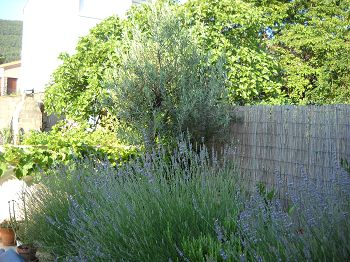GARDENING NOTES FOR JULY
by Gill Storey
When fine weather arrives in July, we are out there at 7 in the morning weeding and planting before the temperature rises too much.
This is the time for pests. Our little enemies have reappeared. We planted our potatoes late because of the chilly spring and now we are fighting the doryphores (Colorado Beetle grubs) which are dining out happily on the potatoes.

Fortunately they are well away from the tomatoes, which are in the same plant group and can be infected. A local gardener suggested mixing bouillie bordelaise (Bordeaux mixture) with the Colorado beetle spray, but then the other locals suggest mixing it with the sulphur spray for the fruit trees in spring. It seems to be a universal remedy.
Another enemy is blanket weed in the pond. To get rid of it wind the weed round a stick before lifting it from the pond. Lavender straw is good for discouraging it but a trickle fountain also helps.
Products are sold which promise not to kill the lilies or the little bugs in the pond but I do not like them. My father used to use copper sulphate (Bordeaux mixture again!) in the pond, but it meant taking out the goldfish.
Every evening, around 4 o’clock, we carry out the parasols and have a quiet time by the pool, enjoying the peace of the garden and the scent of the lavender, before doing the evening watering. This time makes all the work worthwhile.
The main tasks in the garden are:
Flower Garden
 1. Keep on mowing, but during a drought raise the blades a little.
1. Keep on mowing, but during a drought raise the blades a little.
Frequent mowing thickens up the grass from the roots and discourages weeds.
Always clear your clippings away as they encourage moss.
If your lawn develops yellow patches feed them with a nitrogen mix – unless you have a bitch who pees on it, in which case there is no cure except re-seeding. Apply a lawn feed (preferably with a weed killer) on a day after rain.
2. Check roses for black spot and aphids. Soapy water is useful to discourage aphids and if only a few leaves have black spot, they should be nipped off and burnt.
3. Water, water, water. Keep your containers comfortably moist with decent helping of water. If you have deep pot saucers, filling them twice daily should do it. It is better not to water from the top which washes away nutrients, but I use lengths of hose pushed into the pot for my bigger pots in order to get the water to the roots. But do not water your flower beds as it makes plants too tough. The right plant in the right place will not need too much water.
4. Feed, feed, feed. I found a liquid fertiliser called Eco-planète in our local supermarket. This is a mixture of animal and vegetable matter and probably much the same as the product of buckets into which manure and nettles had been dumped. It works well on pots and flower beds. Keep any fertiliser away from ponds.
5. Dead head your roses and garden flowers. This will ensure repeat flowering. Get rid of suckers from roses (as they will come from the rootstock).
6. Take cuttings of dianthus (pinks), sow biennial seeds (wallflowers, lupins and snapdragons (mufliers in French) divide irises after flowering and plant autumn bulbs.
7. Prune wisteria and deciduous magnolias where required. Cut out tired growth on clematis Montana and kerrya.
8. Spray against ants and destroy any wasp nests which are too close to people.
9. Harvest where appropriate – seeds, rose petals, herbs for drying for the winter, lavender. Harvest for drying either early in the morning or in the cool of the evening.
Vegetable Garden
1. If you have an adjacent canal, irrigate your garden. Make little channels and shut off the water for a little to run through the garden. Check with the Mairie for times and days when you can draw from the canal, especially in times of drought.
2. Net your soft fruit against predators and keep picking it. The more you pick the more they flower.
3. Tidy up the strawberry beds when they are no longer flowering.
4. Prune plum trees lightly after gathering their fruit.
5. Harvest beans and peas regularly, as it encourages further growth.
6. Sow the last French beans and also spring cabbage, carrots, turnips, winter spinach and autumn and winter salads. Check the seed displays in the shops for seeds you may not have thought of.
7. Plant out leeks and winter brassicas. (cabbages, Brussels sprouts, cauliflowers etc) Remember, to know when to plant vegetables, see which are being sold on market stalls and in garden shops.
8. Harvest your tomatoes. Continue feeding the plants as long as they are flowering. Usually they will go on till the first frost.
END NOTE
At this time of year, we could expect a heat wave, which means that we cannot spend long hours in the garden catching up on the heavy weed growth which we are seeing this year.
Think safety: If you must work outside, wear a hat and a shirt with sleeves and a collar.
The old ladies in the village keep reminding me and other residents from northern Europe of the dangers of the sun, and often show where they have had cancerous lumps removed from their faces and they grew up wearing hats.
When I am up in the allotment garden, I use an old parasol, which I raise and push into the beds, to make it easier and safer to continue working. It is essential to drink a lot, and a bottled water with some salts in it (such as St Yorre) prevents the loss of essential minerals. Check with the doctor or pharmacy if you are feeling unwell.
Enjoy your garden, protect your skin and stay safe.

